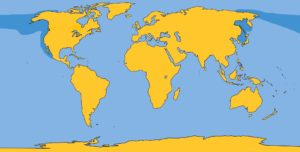 Family: Eschrichtiidae
Family: Eschrichtiidae
Genus: Eschrichtius
Species: E. robustus (Lilljeborg, 1861)
Taxonomic Note: The Western North Pacific population of gray whales is estimated to number between 150 and 300 animals. Little is known of its natural history and appears to be a remnant but distinct population that does not mingle with the eastern Pacific population described here.
The gray whale is unusual not only in that it has been assigned its own taxonomic family, but also in that, unlike most other large whales, it prefers shallow water to deep.
Because grays usually mate and calve in the lagoons of Baja California, they frequently come into close contact with humans. A century ago, this proximity, which made hunting the whales relatively easy, brought the gray whale to the edge of extinction. But over the past half century the eastern North Pacific population has virtually reestablished itself, and the whales’ annual migration has become an ideal opportunity for their observation by cetologists and whale watchers. The recovery of the gray whale is particularly remarkable, as no other large whale has yet recovered to such an extent.
Gray whales feed on bottom organisms, filtering them through the coarsest sieving fibers of any baleen whale. Although gray whales have been observed “feeding” on kelp close to shore along the California coastline, closer observation suggests that they are in fact taking kelp fronds into their cavernous mouths with large quantities of water to gently and carefully sluice microorganisms from the fronds.
Physical Description: The mouth is slightly bowed. The eyes are located just before and above the juncture of the jaws. There are more tactile hairs on the tips of the upper and lower jaws and on the forehead than any other species of whale.
Color: Mottled gray overall, but infested on the dorsal region with the parasitic, crablike crustaceans called whale lice and barnacles, which may create numerous large yellow and white patches. The tongue is pink with a gray tip.
Fins and Flukes: Instead of a dorsal fin there are 9 to 13 small knuckle-like bumps along the dorsal ridge extending from past the mid-back region to the flukes. The flippers are well developed, paddle shaped, and pointed at the tips. The flukes are well spread, pointed at the tips, and have a definite median notch. Pieces of the flukes may be missing from individual grays; such injuries are thought to be the result of killer whale attacks.
Length and Weight: Gray whales reach 45 to 50 ft (13.7 to 15.2 m) in length and may exceed 30 tons (27,000 kg). Females (especially their heads) are believed to be slightly larger than males.
Throat Grooves: There are 2 to 4 large, thick furrows 5 ft (1.5 m) in length, extending the length of the throat. They apparently do not expand during feeding but instead serve to enhance a piston-like action of the tongue while the animal sucks up organisms from the ocean floor.
Baleen Plates: There are 140 to 180 thick, yellow-white plates on each side of the upper jaw, up to 16 in (40 cm) in length, with very long, thick bristles.
Feeding: Grays feed on crustaceans, bottom-dwelling amphipods, small schooling fish, and microorganisms obtained from kelp fronds during migration. The late Dr. Kenneth S. Norris observed at least one gray whale submerging and surfacing in the surge outside a Baja California lagoon in what he felt might be a feeding behavior pattern, the whale allowing water to rush into its mouth for filtering.
Breathing and Diving: Grays normally blow, or breathe, 3 to 5 times in rapid succession before a lengthy, presumably deeper dive, usually 5 to 7 minutes, although it may last as long as 18 minutes. The flukes often are raised into the air prior to a lengthier dive. The blow is forceful and obvious at long range; it appears bushy and U-shaped.
Mating and Breeding: Mating occurs during the southern migration. Calves 16 ft (5 m) long, weighing 1,100 lb (500 kg), are born after a 13 month gestation period, and weaned at 7 months when they reach 27 ft (8 m) and 7.5 tons (6,800 kg). Sexual maturity is reached at between 5 and 11 years when males are 36 ft (11 m) and females 38 ft (11.5 m). Calving occurs every two years.
Herding: During the migration about 6 females with calves are thought to form a herd. Lone whales are observed during the beginning and middle of the migration south and thought to be pregnant females. Other migration groups of from 3 to 5 are made up of non-pregnant females usually accompanied by one of more males. The last to appear seem to be t he previous year’s newborn, making the journey for the first time.
Distribution: Although the gray once was found in both the North Atlantic and North Pacific oceans, now only the large population of the eastern North Pacific Ocean and the tiny population of the western North Pacific Ocean survive.
Migration: From November through February the main population migrates south along the North American coastline to warm-water lagoons of Baja California — one of the longest migratory routes known for a mammal, covering 6,000 to 7,000 mi (9,600 to 11,000 km). The return trip to the Bering Sea begins during February and animals continue to be sighted from the northwest coast through June and July.
GRAY WHALE DISTRIBUTION







